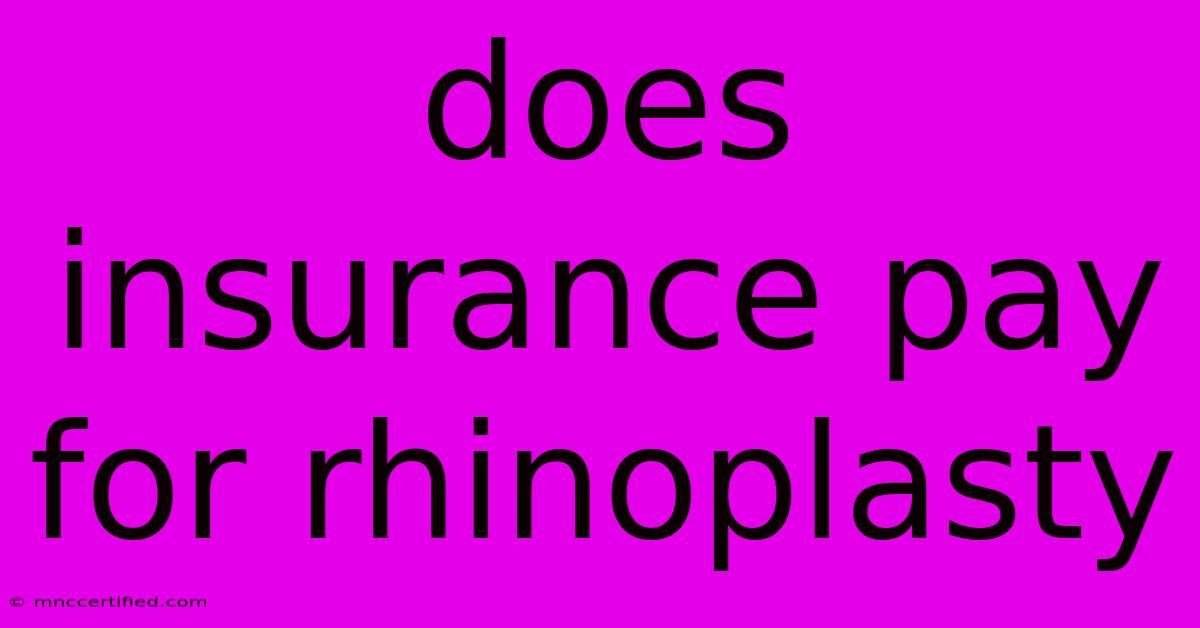Does Insurance Pay For Rhinoplasty

Table of Contents
Does Insurance Pay for Rhinoplasty? A Comprehensive Guide
Rhinoplasty, commonly known as a nose job, is a popular cosmetic surgery procedure. But the cost can be substantial, leading many to wonder: does insurance pay for rhinoplasty? The short answer is: it depends. While insurance rarely covers rhinoplasty purely for cosmetic reasons, there are circumstances where it might contribute to the cost. This comprehensive guide will break down the factors that influence insurance coverage for rhinoplasty.
Understanding Insurance Coverage for Medical Procedures
Before diving into the specifics of rhinoplasty, let's understand how insurance companies generally approach covering medical procedures. Most insurance plans focus on medically necessary procedures – those that address health problems, improve function, or are crucial for a patient's well-being. Cosmetic procedures, which primarily aim to enhance appearance, typically fall outside this category.
When Insurance Might Cover Rhinoplasty
While purely cosmetic rhinoplasty is unlikely to be covered, several scenarios could lead to partial or full insurance coverage:
1. Rhinoplasty for Breathing Problems:
If your rhinoplasty is medically necessary to correct a breathing issue, such as a deviated septum or nasal polyps, your insurance is more likely to cover the procedure. These conditions can significantly impact your quality of life, causing breathing difficulties, sleep apnea, or chronic sinus infections. Documentation from your ENT (Ear, Nose, and Throat) doctor is crucial here. They need to clearly outline the medical necessity of the surgery and its impact on your health.
2. Rhinoplasty After an Injury:
If you've suffered a nasal injury resulting in a broken nose or other structural damage, rhinoplasty to repair the damage and restore proper function is more likely to be covered by insurance. Medical records documenting the injury and the need for reconstructive surgery are vital.
3. Rhinoplasty to Correct Birth Defects:
Congenital nasal deformities or birth defects affecting nasal structure can be covered by insurance. This requires thorough medical documentation supporting the necessity of surgery to address the birth defect and its impact on breathing or overall health.
Factors Influencing Insurance Coverage
Several factors influence whether your insurance company will cover part or all of your rhinoplasty:
- Your Insurance Plan: Different insurance plans have different coverage policies. Some may offer more extensive coverage than others. Review your policy carefully or contact your insurer directly for clarification.
- Your Doctor: The way your doctor documents the medical necessity of the procedure significantly impacts your chances of coverage. Choose a surgeon who understands the insurance process and can provide clear, comprehensive documentation.
- Pre-authorization: Many insurance companies require pre-authorization before covering any major procedure. Failure to obtain this authorization can result in higher out-of-pocket costs.
What to Do Before Your Rhinoplasty
- Consult Your Doctor: Discuss your goals and concerns with your surgeon. They can help you determine if your case qualifies for insurance coverage and assist you with the necessary documentation.
- Check Your Policy: Carefully review your insurance policy to understand your coverage limitations and requirements for pre-authorization.
- Gather Medical Records: Compile all relevant medical records, including those documenting any injuries, breathing difficulties, or birth defects.
- Prepare for Potential Out-of-Pocket Costs: Even with partial insurance coverage, you’ll likely face some out-of-pocket expenses. Be prepared for these costs.
Conclusion: Planning is Key
While insurance rarely covers purely cosmetic rhinoplasty, there are several scenarios where it might offer partial or full coverage. The key is thorough planning and proper documentation. By understanding your insurance policy, working closely with your doctor, and gathering necessary medical records, you can increase your chances of receiving financial assistance for your rhinoplasty. Remember, transparency and clear communication with your insurance provider and your surgeon are crucial.

Thank you for visiting our website wich cover about Does Insurance Pay For Rhinoplasty. We hope the information provided has been useful to you. Feel free to contact us if you have any questions or need further assistance. See you next time and dont miss to bookmark.
Featured Posts
-
Cargo Liability Insurance Coverage
Nov 16, 2024
-
Erivos Wicked Whistle A Gorgeous Version
Nov 16, 2024
-
Patriot Insurance Agency Monroe Nc
Nov 16, 2024
-
Silo Season 2 What We Want To Know
Nov 16, 2024
-
Wake Forest Volleyball Campbell Adapts
Nov 16, 2024